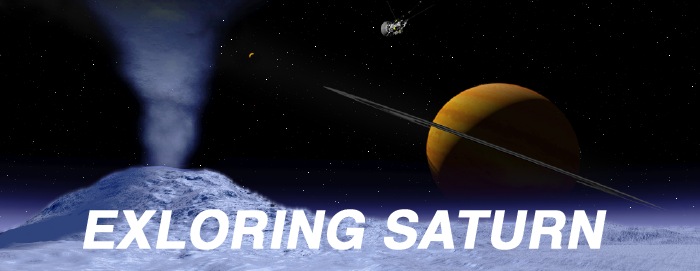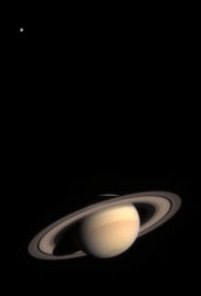 |
|||||||
| One of the Most Complex and Ambitious Ventures in the History of Space Exploration | |||||||
| Saturn | Rings | Moons | Titan | Cassini | Science | Huygens | Resources |
THE LATEST CASSINI NEWS FROM SATURN »»
IMPORTANT CASSINI FINDINGS ABOUT TITAN »»
Imagine this: Saturn's moon Titan is so large that it's even bigger than two planets – Mercury and Pluto.
The tiny white dot at upper left in this Cassini photo is the giant moon Titan 760,000 miles from the ringed planet Saturn at lower right.
We know that each of the planets of our Solar System moves in a path around the Sun. And that a moon circles around a planet. Titan is a moon, not a planet. That means Titan does not orbit the Sun by itself, but goes around its planet Saturn.
Most planets of the Solar System are bigger than most moons. You might ask, how can this moon Titan be bigger than a planet? The answer lies in the fact that Mercury and Pluto are very small planets and Mercury is a very big moon. Even though they are small bodies, Mercury and Pluto orbit the Sun, which makes them planets. Titan, on the other hand, is a moon because it orbits around a planet – Saturn, which in turn travels around the Sun.
Titan is so large that it even has clouds and an atmosphere. In fact, it probably is the only moon in our Solar System with a significant atmosphere.
Though it has "air" surrounding it, humans could not breathe it because some of the gases in its air are poisonous to us. Also, we need to breathe oxygen and there is none in Titan's atmosphere.
The clouds surrounding Titan are so thick that even the Voyager spacecraft, which flew quite close to the moon, could not see down through the clouds to the moon's surface. So, we don't know what the surface of Titan looks like, although we think it must be very cold. Titan could have mountains and oceans, but we won't know for sure until our probe visits.
Titan's surface water and chemicals are frozen solid as ice at nearly 400 degrees below zero. That suggests life neither exists there now nor existed there in the past. On the other hand, asteroids punching the surface from time to time might have warmed areas on the surface sufficiently to mix organic compounds and liquid water generating the same kind of chemistry that led to life on Earth.
What Do We Know About Titan?
Titan is the most important of Saturn's many moons.
The first color picture from the surface of Titan by Huygens on January 14, 2005.Titan is the only moon known to have a large atmosphere.
- It is the biggest of the planet Saturn's moons. Titan's diameter of 3,200 miles makes it larger than the planet Mercury with a diameter of 3,031 miles and the planet Pluto with a diameter of 1,442 miles.
- Of all the moons in our Solar System, only the planet Jupiter's moon Ganymede is larger. Its diameter is 3,270 miles. Astronomers used to think Titan was the largest moon in the Solar System until they realized that Titan's atmosphere is very thick and its solid surface is slightly smaller than Ganymede's.
- Titan keeps its distance at an average of 760,000 miles from Saturn.
- All of the rest of Saturn's moons are far smaller than Titan.
- Three-and-a-quarter Earth Moons could fit inside Titan.
- Titan contains nearly twenty times as much matter as all the rest of Saturn's moons and rings combined.
The four elements in Titan's atmosphere – carbon, hydrogen, nitrogen, and oxygen – are the same main elements that make up living things on Earth. However, in Titan's atmosphere, the nitrogen and methane are bombarded by high-energy particles and ultraviolet light. That creates a brownish-orange haze that sort of clumps together and rains down on Titan's surface.
- Its atmosphere is mostly nitrogen, just like the atmosphere surrounding Earth, but thicker.
- Its atmosphere contains methane, which is composed of carbon and hydrogen and is found in small amounts in Earth's atmosphere.
- Only tiny amounts of oxygen, which we need to live, are found in Titan's atmosphere.
In many ways, Titan today probably is a lot like Earth was hundreds of millions of years ago. However, it would seem that the extremely cold conditions there would make life as we know it unlikely.
Great Lakes of Smoldering Tar?
Even though Voyager 1 was unable to see Titan's surface through the brownish-orange haze as it flew by in 1980, scientists were able to figure out from information radioed back that Titan's frigid surface might have vast lakes of liquid ethane. Under such lakes could be a thin layer of frozen methane and ammonia. Below that could be a layer of frozen water ice.
They still see the giant moon as holding water in the form of ice. However, a new radar view of Titan in 2003 seemed to show the big moon's surface covered by oily lakes of liquid hydrocarbons.
The speculation has been that Titan is deeply frozen now, but millions of years ago asteroids and comets crashed into its surface digging deep craters and heating the surface for a time.
Astronomers bounced radar pulses from the 1, 000-ft.-wide radiotelescope at Arecibo, Puerto Rico, off Titan's surface. The radar signals penetrated the smoggy haze to reveal what looked like a pitted surface marked by lakes or even seas of liquid organic chemicals.
Previously, astronomers had thought that the moon's nitrogen atmosphere, thick with clouds of methane, had obscured a moon covered by a miles deep ocean of tarry hydrocarbons. Now, the radar signals returning to Arecibo, as well as to a radiotelescope at Green Bank, West Virginia, formed images that reminded astronomers of glints of light shining from lakes on Earth. On Titan, that would translate into lakes of organic compounds that were sufficiently liquid to reflect glints of radio waves.
How many lakes might there be? There might be as many as 80 giant lakes from 30 to 100 miles across. Or else there might be thousands of small lakes.
What Would We Like To Know?
An infrared photo of Titan snapped by the Hubble Space Telescope in 1994 showed an intriguing bright spot. Scientists don't know whether that bright region is a continent or something else. The work of the Cassini spacecraft and its Huygens lander was designed to answer this and many other questions about Saturn and Titan.
Huygens carried scientific instruments to study the atmosphere and surface of Titan. A camera recorded more than a thousand images of Titan's surface and clouds. Another instrument used radio signals to measure Titan's winds. Three sensors analyzed the moon's atmosphere. Huygens survived the landing on January 14, 2005, to photograph and measure Titan's surface.
| Top of this page | Saturn main page | The Planet | The Rings | The Moons | Solar System |
| Cassini probe | Cassini Science | Titan moon | Huygens | Internet Resources | |
| STO Cover | Search STO | Questions | Copyright 2005 Space Today Online | ||

